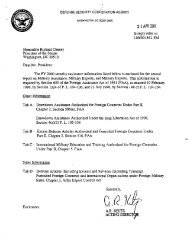memorandum of justification concerning human ... - Just the Facts
memorandum of justification concerning human ... - Just the Facts
memorandum of justification concerning human ... - Just the Facts
You also want an ePaper? Increase the reach of your titles
YUMPU automatically turns print PDFs into web optimized ePapers that Google loves.
UNCLASSIFIED<br />
- 73 -<br />
2008, groups reached Bogotá, where indigenous leaders met with nine government<br />
ministers and established a new forum to discuss previous agreements between <strong>the</strong> GOC<br />
and <strong>the</strong> groups.<br />
NGOs report that <strong>the</strong> situation in Cauca remains tense as <strong>the</strong> Prosecutor General‘s<br />
Office continues its efforts to prosecute indigenous leaders, including Aida Quilcue, for<br />
<strong>the</strong> kidnapping <strong>of</strong> a policeman during <strong>the</strong> protests.<br />
Security Situation for Afro-Colombian Communities<br />
Five percent <strong>of</strong> Colombia‘s territory (4.7 million hectares) is collectively titled to<br />
Afro-Colombian communities. Afro-Colombians make up between 11 and 25 percent 48<br />
<strong>of</strong> Colombia‘s population. The departments with <strong>the</strong> highest population <strong>of</strong> Afro-<br />
Colombians are Chocó (82 percent Afro-Colombian), San Andrés and Providencia (57<br />
percent Afro-Colombian), Bolívar (27 percent Afro-Colombian), and Valle de Cauca (27<br />
percent Afro-Colombian). As is <strong>the</strong> case in areas populated by indigenous communities,<br />
illegal groups have attempted to exploit for criminal purposes many <strong>of</strong> <strong>the</strong> departments<br />
with high Afro-Colombian populations, which in turn endangers <strong>the</strong> local population. In<br />
order to combat this activity, <strong>the</strong> Armed Forces maintain a presence in some <strong>of</strong> <strong>the</strong>se<br />
areas. In doing so, <strong>the</strong> Armed Forces continue to take action against <strong>the</strong> illegal groups<br />
that threaten <strong>the</strong> security, and, <strong>the</strong>refore, <strong>the</strong> land and property rights, <strong>of</strong> Afro-<br />
Colombians. (For more on actions taken against illegal groups, see Section<br />
7046(b)(1)(B)(iii) and (b)(2).)<br />
According to <strong>the</strong> Association <strong>of</strong> Internally Displaced Afro-Colombians<br />
(AFRODES), as <strong>of</strong> July 2009, 49 850,000 Afro-Colombians have been displaced since<br />
1997 (including 32,353 in 2005; 30,451 in 2006; and 44,087 in 2007; and 33,519 in<br />
2008). NGOs allege illegal armed groups have forced Afro-Colombian communities <strong>of</strong>f<br />
<strong>the</strong>ir land, leading <strong>the</strong> group to comprise an estimated one third <strong>of</strong> IDPs in Colombia. In<br />
some cases, o<strong>the</strong>rs complain that individual Afro-Colombians have sold land, legally or<br />
illegally. Since much <strong>of</strong> this land is located in areas where government institutions are<br />
weak or, in some cases, not present, legal enforcement <strong>of</strong> collective title is difficult.<br />
Afro-Colombian Land Disputes<br />
In <strong>the</strong> communities <strong>of</strong> Jiguamiandó and Curvaradó in <strong>the</strong> Department <strong>of</strong> Choco,<br />
<strong>the</strong> Colombian government has been working on resolving land disputes between local<br />
Afro-Colombian communities and palm oil companies currently occupying <strong>the</strong> Afro-<br />
48 Colombian census figures cite 11 percent while NGOs and Afro-Colombian groups contest this figure, saying it is too low<br />
and <strong>the</strong>y really make up 25 percent <strong>of</strong> <strong>the</strong> population.<br />
49 Most recent information available as <strong>of</strong> July 15, 2009.<br />
UNCLASSIFIED



